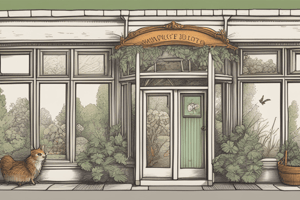Podcast
Questions and Answers
What is the primary purpose of the padding property in a control?
What is the primary purpose of the padding property in a control?
- To set the internal distance in pixels from the edge of a form or control’s client area (correct)
- To specify the upper-left position of a control in a container
- To configure the margin property of a control
- To define the spacing between adjacent controls
Which of the following controls does not support padding?
Which of the following controls does not support padding?
- PictureBox
- TextBox (correct)
- Button
- Label
What is the purpose of the margin property in a control?
What is the purpose of the margin property in a control?
- To specify the upper-left position of a control in a container
- To configure the padding property of a control
- To define the internal distance from the edge of a form or control’s client area
- To set the spacing between adjacent controls (correct)
What determines the order in which a user can navigate through the controls at run-time?
What determines the order in which a user can navigate through the controls at run-time?
What is the term for the logical ordering of controls in a container, with controls higher in the stack being rendered on top of controls lower in the stack?
What is the term for the logical ordering of controls in a container, with controls higher in the stack being rendered on top of controls lower in the stack?
What is anchoring in the context of dynamic layout?
What is anchoring in the context of dynamic layout?
What is docking in the context of dynamic layout?
What is docking in the context of dynamic layout?
What is the purpose of using container controls in dynamic layout?
What is the purpose of using container controls in dynamic layout?
What is the purpose of a Splitter in dynamic layout?
What is the purpose of a Splitter in dynamic layout?
What determines the docking order of multiple controls docked to the same edge?
What determines the docking order of multiple controls docked to the same edge?
Flashcards are hidden until you start studying
Study Notes
Layout System Fundamentals
- The layout system helps control positioning, sizing, and ordering to establish a basic composition.
- There are two types of layouts in Windows Forms: Fixed Layout and Dynamic Layout.
Fixed Layout
- Controls are positioned in a fixed way, like they are glued to the form.
- They cannot adapt to changes in their surroundings.
- The padding property is the internal distance in pixels from the edge of a form or control's client area that child controls can't intrude on.
- Padding is implemented on the base Control class and the default is to have zero padding.
- Some controls don't support padding, such as TextBox, ListBox, ListView, and MonthCalendar.
- Margins define the spacing between adjacent controls, configured using a control's Margin property.
- Control Z-Order specifies a control's location in a container relative to the container's upper-left corner.
- Control Tab Order is the sequence in which a user can navigate through controls at run-time, registered by setting the Boolean TabStop property to true.
Dynamic Layout
- After controls are positioned, sized, and z-ordered, a user may resize the form, requiring further adjustments.
- Anchoring preserves the distance between the edge of a control and the adjacent edge of a control's container.
- Docking is a way to identify the edge that a control should "stick" itself to.
- Using Docking, a control can take whatever space remains in the client area.
- Docking and Z-Order interact, with controls docked to the same edge in reverse z-order priority.
Layout Controls
- Container controls can be used to break a layout problem into smaller pieces.
- Container controls share the same layout characteristics as forms, with child controls that can be anchored or docked.
- Anchoring and docking settings of a container control are relative to the edges of the container, not the form.
Splitting
- Splitting allows resizing some controls independently of the size of the form.
- A Splitter is a bar that separates two controls, allowing users to drag the bar to change the proportion of the space shared between the controls.
- The Orientation property can be used to set the split bar orientation.
Studying That Suits You
Use AI to generate personalized quizzes and flashcards to suit your learning preferences.




